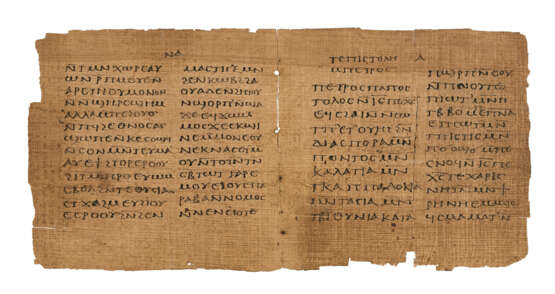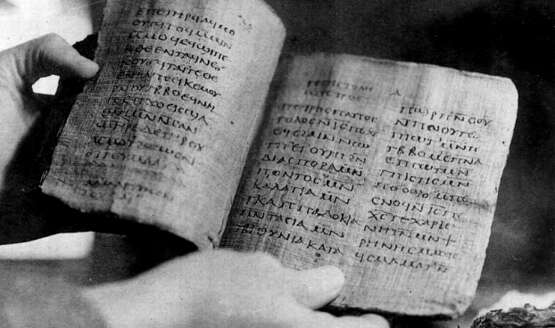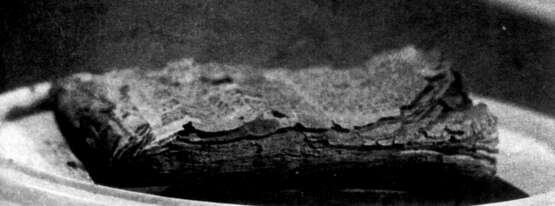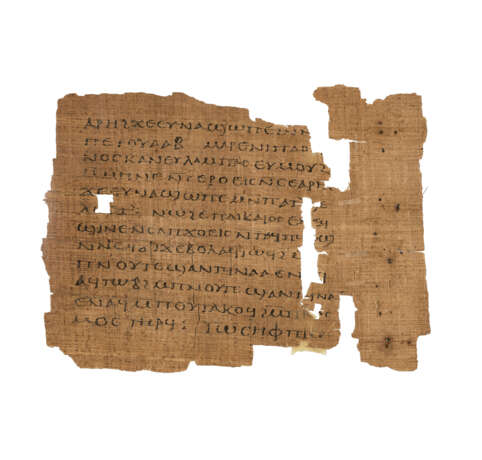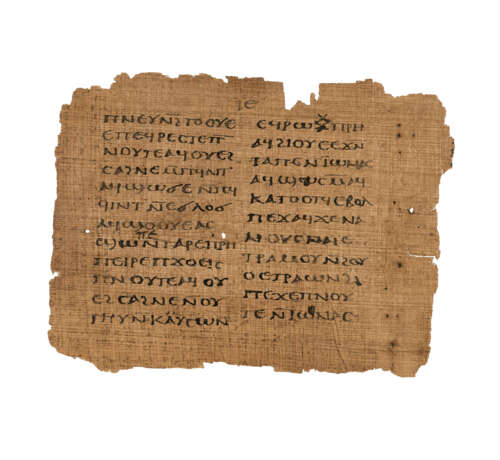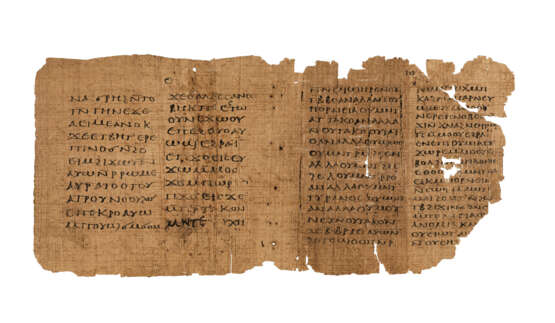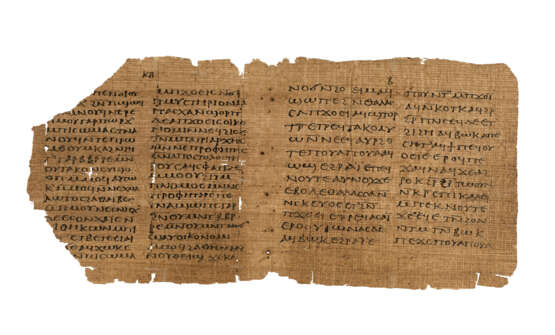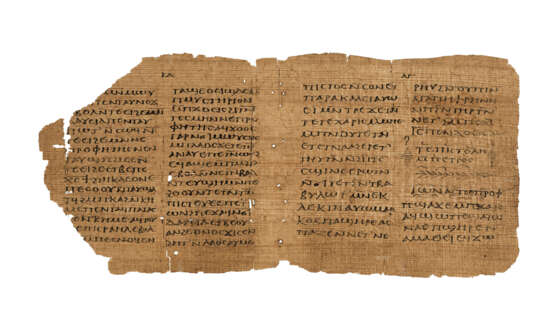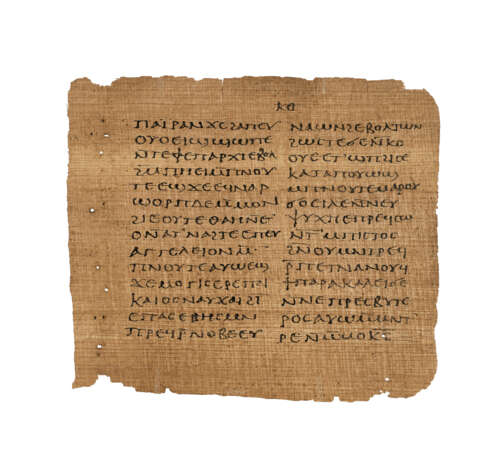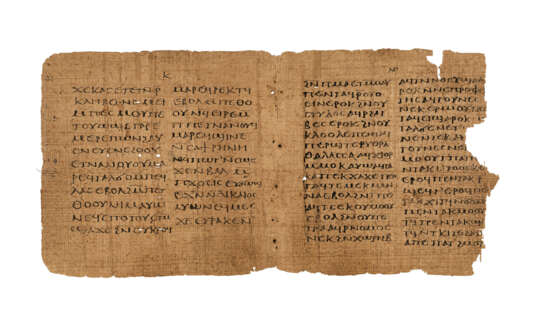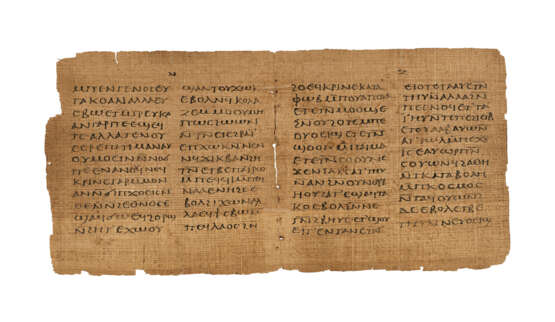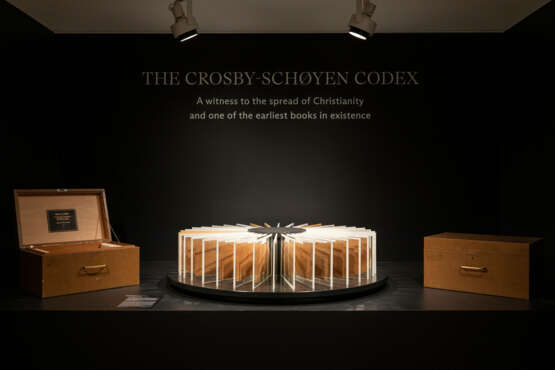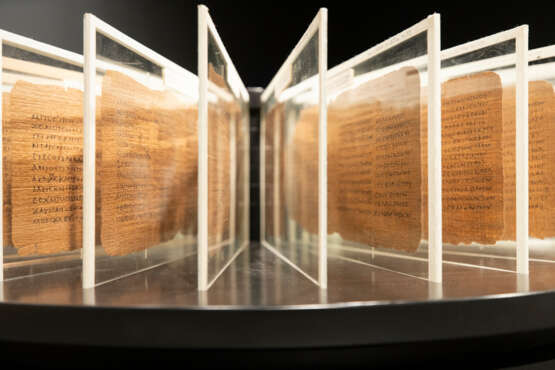ID 1214838
Лот 1 | The Crosby-Schøyen Codex
Оценочная стоимость
£ 2 000 000 – 3 000 000
The Crosby-Schøyen Codex, in Coptic, manuscript on papyrus [Upper Egypt, middle 3rd century into 4th century]
The earliest known book in private hands, and one of the earliest books in existence. The earliest Christian liturgical book. The earliest complete texts of two books of the Bible, 1 Peter and Jonah. One of the earliest and most complete texts of Melito's tractate on the Passover. One of the earliest witnesses of Maccabees in any language.
146 x 152mm. A square-format single-quire papyrus codex, 51 complete or substantially complete leaves (of originally 68, including the outer wrapper), with fragments and stubs at beginning and end, each fragment, leaf and bifolium now preserved between 35 double-sided archival plexiglass plates, with a 36th double-sided glass plate added for the unplaced fragments (see Provenance), 11-18 lines written in two columns in a bold, large Coptic hand by a single scribe, the dialect generally Sahidic, but with occasional Bohairic and Sub-akhmimic variants (for a comprehensive codicological analysis of the codex, see Robinson, in Goehring, 1990, pp.XLIII-XLVIII; on the script, dialect forms and spellings, see Goehring, 1990, pp.LI-LXII), subscript and superscript titles, contemporary Coptic pagination survives, the first surviving page number ⲓⲑ (19) on f.13, decorated cartouches at the end of the texts of Melito and Jonah (ff.26 and 33), the opening fragment a flyleaf with remnants of leather binding (the opening 3 sheets with fragments surviving only at the spine as uninscribed inner margins, the first sheet originally likely front and back flyleaves with no text, the opening of Melito missing, f.4 the first with fragments of text, continuing in fragmentary fashion until f.13, whereupon more or less complete and from ff.23-62v entirely so, ff.63-68v with lacunae, a pale vertical lozenge over the sewing holes in the central fold of ff.34-35 where perhaps a sewing guard may have been, some darkening and defects but otherwise in exceptional condition). In two bespoke locking wooden boxes. With a custom-made rotating display plinth.
Provenance:
(1) During the 20th century, four outstanding finds of buried papyri and parchments transformed study of the Bible and early Christianity. The Dead Sea Scrolls, which were recovered from 1947 in a series of discoveries in the Judaean Desert, are chiefly in Hebrew with some Greek and Aramaic material, and date from the 2nd century BC to the 1st century AD. The other three finds were preserved in the dry sands of Egypt: the 'Chester Beatty Biblical Papyri', a group of 11 papyrus codices of Greek biblical texts dating from the 2nd to 5th centuries, found in 1930; the Nag Hammadi Library, 12 papyrus codices of Gnostic Christian texts in Coptic dating from the mid-4th to early 5th centuries, found in 1945; and the Bodmer Papyri found in the early 1950s. Of these Egyptian finds, the Bodmer Papyri, in various forms of Coptic, Greek and Latin dating from the 2nd to the 7th centuries, are both the most numerous, the most intact and the widest ranging in language, date and content. They comprise Biblical texts, Christian writings and pagan literary texts. Their discovery revolutionised understanding of the history of early Christian writings, for they surpass ‘in the quality of their preparation, in the length of their texts and in their textual significance’ all previous findings of Biblical papyri. They are collectively named after Martin Bodmer (1899-1971), Swiss bibliophile, scholar and collector, since most were acquired by him, despite the fact that the remainder are treasured in other famous collections, both public and private – such as the Chester Beatty Library, Duke University, the Museum of the Bible in Washington, D.C., and the Collection of Martin Schøyen. For more on these finds, see Nongbri, 2018.
The Crosby-Schøyen Codex is part of the Bodmer Papyri find. Because the find itself was unrecorded, its precise limits and location have been the subject of much debate. Bodmer’s secretary, Odile Bongard, who made many of the purchases in Egypt on his behalf, was told by the dealer Phocion Tano, through whom she negotiated, that the manuscripts were unearthed in an underground chamber, perhaps a tomb or a storehouse, in Mina or Minia near Asyut (C. Méla, Legends of the Centuries, Looking through a Legendary Collection, Martin Bodmer Foundation, 2004, pp.34-38).
Another account of their origin, compiled from local traditions, assigns their provenance to the monastic complex of Pachomius near Dishna (B. Van Elderen, ‘Early Christian Libraries’, The Bible as Book, the Manuscript Tradition, 1998, pp.50-56 and Robinson, in Goehring, 1990, pp.IX-XLVII). This provenance is perhaps the more plausible: if the codex, as is generally held (see Contents below), is an Easter lectionary, then internal textual evidence indicates that it was intended to be the liturgy for the annual Easter celebration of the Pachomian koinonia of monasteries (on this, see Pietersma and Comstock, 2011, pp.27-46).
(2) Maguid Sameda (b.1900), Cairo antiquarian dealer. The modern provenance of what came to be known as the Mississippi Codices, and subsequently the Crosby-Schøyen Codex, has been most recently and accurately charted by Daniel B. Sharp (Sharp, 2023, esp. pp.174-177). On November 5th 1954, the Cairo antiquarian dealer Maguid Sameda wrote to David Moore Robinson at the University of Mississippi about the Egyptian export procedures for a gilded wooden Isis that he had recently purchased; in that same letter, he mentioned that there had been a 'find of books of Papairi [sic] this year [...] either Akhmeimic or Saidic': he was most likely referring to the Bodmer papyri, and what would later become the Mississippi Codices. Sameda and Robinson remained in contact and arranged to meet in Lucerne in the summer of 1955.
(3) Friends of the Library of the University of Mississippi. In the summer of 1955, David Moore Robinson (1880-1958), American Classical archaeologist, brought the Mississippi codices on approval back to the US from Lucerne, Switzerland, for the Friends of the Library. On 14 November of that year, he sent a cheque for $5,000, payable to the Swiss dealer Ernst Kofler-Truniger (with whom Maguid Sameda collaborated on sales to major institutions) for the two Coptic Codices and also a collection of 7 fragments of Coptic documents; a collection of 14 fragments of Greek documents; and a collection of 66 fragments of Greek miscellaneous documents. The Friends of the Library raised money to pay off the loan, which they did by 1960 thanks to several donations (see Sharp, 2023, p.174). Of the many donors, Margaret Reed Crosby was one of the more generous, donating $2,500, which led to Mississippi Coptic Codex I being renamed the ‘Crosby Codex’, after her husband. The Friends of the Library retained ownership of the codices from 1955 to 1963. William H. Willis, renowned classicist and papyrologist, introduced the Mississippi codices to the international community at the ninth International Congress of Papyrology, held in Oslo in 1958: the two Coptic codices were described in detail in his article and were known as Mississippi Coptic Codex I (or the Crosby Codex, subsequently the Crosby-Schøyen Codex) and Mississippi Coptic Codex II (Willis, 1961, pp.381-392). The codices were kept on deposit at the University of Mississippi, with ownership transferred on 8 May 1963 to:
(4) The University of Mississippi, where they remained until 1981. The codices were deaccessioned to raise funds to purchase the Rowan Oak papers, archival materials connected to William Faulkner (see Sharp, 2023, p.177, note 74). On 5 May 1981 the two Coptic codices were sold for $225,000 to:
(5) H.P. Kraus (1907-1988), one of the leading rare book dealers of the second half of the 20th century. Mississippi Coptic Codex II was purchased by Robert Van Kampen (1938-1999) and is now in the Van Kampen Foundation (another part of this codex is at the Bodmer Foundation, P. Bodmer XXII). Mississippi Coptic Codex I (our Crosby-Schøyen Codex) was sold in 1983 to:
(6) Winsor T. Savery, of Houston, Texas, through his 'Pax ex Innovatione' Foundation. While in Savery's possession, the codex was renamed 'The Savery Codex'. In a letter dated 31 July 1985 addressed to James M. Robinson, Savery granted him the authority to translate and publish the codex, a task which was concluded under the subsequent ownership of Martin Schøyen. Sold by Savery at:
(7) Sotheby’s, 6 December 1988, lot 29 (‘The Mississippi Codex’), to:
(8) The Schøyen Collection, MS 193.
In a 1990 exchange with Duke University, 41 other fragments were acquired by Martin Schøyen and reattached to their parent manuscript by Dr Walter Cockle of University College London. These fragments had been classified as P. Duk. Inv. C125 and had been bequeathed to Duke University in 1988 by W.H. Willis. Willis had, in turn, obtained them from Martin Bodmer in 1967 (according to his gift letter to Duke University of 29 December 1988: 'knowing my interest and earlier work on the Crosby, Dr Bodmer, when I visited him in 1967, gave me the numerous detached fragments of its missing first eight leaves that he found among the codices he had acquired in 1955'). The University of Mississippi, through Willis, had previously had these fragments on loan from Bodmer in 1962, with permission to photograph them and seek their points of attachment to the Codex itself (see Sharp, p.178), and had attempted to acquire them. Willis persisted in his attempts to acquire the fragments in order to reunite them to their parent codex, even after leaving Mississippi for Duke in 1963, but without success (a 1963 letter from Rodolphe Kasser to Willis communicated Bodmer's refusal to sell the fragments, but opened up to the possibility of an exchange for the greater academic good of reuniting them to the Crosby Codex: 'M. Bodmer [...] est tout à fait conscient de l'avantage que représenterait pour votre travail et pour la science en général, la réunion définitive de ces fragments au Crosby Codex; c'est pourquoi il pense que l'idée d'un échange ne saurait être exclue a priori'). Although according to Sharp (Sharp, 2023, p.179), an exchange never occurred, the fragments must eventually have returned to the Bodmer, and then left again, since in 1967 they were entrusted once more by Bodmer to Willis (in a 1989 letter, Kasser writes to Hans Braun, Director of the Bodmer Foundation: '[...] lors de son passage à la Bodmeriana (en été 1967, je l'ai vérifié), M. Martin Bodmer lui a 'confié [...] les fragments du Crosby Codex alors en sa possession [...] ces fragments sont sans doute joints aujourd'hui encore au reste du Crosby Codex [...]'.
Other fragments from the manuscript are at the Chester Beatty Library.
Dating:
The Crosby-Schøyen Codex has been variously dated over the years on paleographical grounds from the 2nd to the 5th centuries (Tito Orlandi tentatively suggested a date as late as the 6th century, but in response to a query from James Goehring, he responded that his dating was preliminary, since he had not actually seen the manuscript: see Robinson, in Goehring, 1990, p.XXXIII, note 13). William H. Willis dated it to the second half of the 2nd century or to the 3rd (Willis, 1961, p.389); Colin H. Roberts dated it to late 2nd or 3rd century (Robinson, in Goehring, 1990, p.XXXIII); Christopher de Hamel to c.250 in his Sotheby's description; Allen Cabaniss to c.300 (Cabaniss, 1961, p.70); Eric G. Turner thought it 3rd or 4th century (Turner, 1977, p.137); Kurt and Barbara Aland opted for the later end of the spectrum, c.400 (Aland, 1987, p.197). In 2020, Hugo Lundhaug conducted radiocarbon analysis of one of the leaves of the codex, which confirmed the academic consensus of a date from the middle of the 3rd century into the 4th (see Lundhaug, 2020).
According to Goehring, 'the Crosby-Schoyen codex is markedly similar to the third century papyrus codex of the Gospel of John contained in the Bibliothèque Bodmer (P. Bodmer II). While the latter differs in that it is constructed with five quires rather than one and is written with a single column to a page rather than two, in its general appearance, size, papyrus quality and scribal hand it has been identified as the closest parallel to the Crosby-Schoyen codex and likely comes from the same scriptorium' (Goehring, 1990, p.LI). A more recent assessment of the dating of P. Bodmer II into the 4th century can be found in B. Nongbri, 'The Limits of Palaeographic Dating of Literary Papyri: Some Observations on the Date and Provenance of P.Bodmer II [P66]', Museum Helveticum, 71, no 1 [2014], pp.1-35). For a discussion on the handful of small square-format codices of this period with similar handwriting see Nongbri, 2018, p.199.
Another comparable codex in format, size and thematic content (in that it is a miscellany with the texts having the common denominator of the theme of Easter) is the Greek 3rd- or 4th-century P. Bodmer VII-VIII (Papyrus 72), also known as the Bodmer Miscellaneous codex (on this see Wasserman, 2005).
Format:
The Crosby-Schøyen Codex is one of a handful of well-preserved witnesses of a development in cultural transmission and in the history of the book that would not be rivalled in significance until the 15th-century innovations of Gutenberg and the 20th-century revolution in electronic publishing and communication.
Charting the history of the development of the codex and the rapid shift from papyrus roll to book form in the first few centuries of the first millennium requires a certain amount of caution, since the vast majority of our evidence comes from Egypt, thanks in part to the conducive climatic conditions that allowed for this evidence to be preserved. It is true that from these Egyptian finds the Christian Bible almost always appears in codex form, whereas literary texts continue to be written on rolls until the 4th century, but we run the risk of generalising if we extrapolate this trend to the wider Graeco-Roman world: as Cillian O'Hogan points out in a British Library blogpost ('The Beginnings of the Codex', 12 June 2015), the recently-discovered Peri Alupias of Galen (Thessaloniki, Vlatadon 14), for instance, contains references to parchment codices at Rome in the late 2nd century. That said, there is a clear interrelation between the transition from papyrus to parchment; from roll to codex; and the spread of Christianity itself.
Papyrus was manufactured in rather narrow sheets, usually around 15-20cm wide. Ordinarily, twenty of these were glued together to make a roll between 340 and 360cm long. These were the basic units supplied for writing: if necessary, two or more of these could be joined together for the written roll, while for a codex the manufactured roll would be cut to give double-leaf sheets that could be stacked, folded and sewn together. Individual sheets or tablets of various materials had been joined together to make notebooks for ephemeral purposes, but it was the requirements of the Christian church that encouraged the adoption of the codex format for enduring records. The codex had several advantages over the roll: it enabled longer texts to be produced together in a single volume; the form itself would have distinguished it from pagan literature or from Jewish religious texts; the codex allowed almost instant reference and access from one part of holy scripture to another; and it doubled the writing area, since both sides would be written on.
The Crosby-Schøyen Codex is constructed as a single-quire codex, a feature indicative of the most primitive form of book. Goehring (Goehring, 1990, p.XLIV) states that it was constructed from four rolls, producing respectively 8, 8.5, 8.5 and 9 sheets. Thus the codex, when complete, consisted of a stack of 35 sheets: 33 of these sheets were bifolia, and two of them were stubbed singletons, meaning that the codex consisted of 68 folios, or 136 pages. What is exceptional is the surviving contemporary pagination: very few early codices carry any indication of pagination or foliation (among these we find Papyrus 46, a late 2nd/early 3rd-century codex split between the Chester Beatty Library — P. Chester Beatty II — and the University of Michigan — Inv. 6238; and the Beatty (Princeton, Cologne, Madrid, Barcelona) codex of Ezekiel, Daniel, Susanna, and Esther (LDAB 3090)). In his 1988 Sotheby's description, Christopher de Hamel wrote that the pagination in this manuscript: '[...] has an importance not only in understanding the codicological structure of the volume itself but also in the wider history of the evolution from the classical roll into the codex which enabled the reader to move around the text effortlessly and find specific passages'. On the pagination of early codices and of this manuscript in particular, see B. Nongbri, 2022.
Contents:
Melito of Sardis, Peri Pascha, ff.4-26, the pages numbered [ⲁ]-ⲙⲉ ([1]-45); 2 Maccabees 5:27-7:41, ff.26v-36, the pages numbered ⲙⲋ-ⲝⲋ (46-66); 1 Peter, ff.38-54, the pages numbered ⲁ-ⲗⲅ (1-33); Jonah, ff.54v-62v, the pages numbered ⲁ-[ⲓⲍ] (1-[17]); a Pachomian homily, ff.63-68v.
The texts assembled in the Crosby-Schøyen Codex are Paschal in nature, having the themes of death, martyrdom, suffering and resurrection ('Leiden, Passion, Ostern', according to Bethge, 1993, p.257), and academic consensus is that the manuscript served as an Easter lectionary, which would make it, as de Hamel described it, 'the earliest intact service book in Christendom'.
Melito of Sardis, Peri Pascha
'The tractate On the Passover by Melito, the second century bishop of Sardis, enjoyed considerable popularity in Egypt. Nine versions of the text in three different languages and various states of preservation have surfaced in Egypt. The Greek tradition is represented by the well preserved Papyrus Bodmer XIII [...], and fragments of a manuscript discovered at Oxyrhynchus. Five distinct Coptic versions have also been identified. The Crosby-Schøyen text [...] is by far the most complete.' (Goehring, 1990, p.3).
There are in fact seven extant Coptic witnesses, of which the Crosby-Schøyen text is by far the most complete. These are represented by fragments or single leaves and include a vellum fragment from the Wādī Sarǧa, datable to the 4th century (London, British Library Or. 9035 (4)); two Oxyrynchus papyrus fragments from around the 5th century (Oxford, Bodleian Library, MS. Gr. th. d. 4 (P)); a further highly fragmentary vellum fragment in Oxford (Bodleian Library, MS. Copt. e. 74/4 (P)); a 6th-7th century vellum leaf in Paris (Bibliothèque Nationale, Copte 131 (2) (f.134)); a papyrus fragment probably from the 4th century in California (Balboa, Private Collection Robert Bruce); and a papyrus fragment from the 4th century in Oslo (The Schøyen Collection MS 2337).
The text is an early meditation on the Paschal mystery, inspired by the Jewish Haggadah of Pesach and styled on the Gospel of John. It is the story of the Passover lamb as a prefiguration of the sufferings of Christ. Eusebius writes about Melito in his Historia Ecclesiastica and called this homily Peri tou Pascha, an identification that was doubted for much of the 20th-century (see, for example, P. Nautin, Revue d'histoire ecclésiastique, XLIV, 1949, pp.429-38), but which is vindicated by the unique colophon in the present manuscript: 'PERI PASCHA MELITON'.
Of the 41 fragments acquired by Martin Schøyen from Duke University in 1990, 9 were identified on the basis of their content as belonging to the missing pages of Melito's text and were reattached codicologically by Dr W. E. H. Cockle. Four others had previously been identified as part of the text but could not be codicologically placed. The 26 remaining fragments remain unidentified, but most likely also belong to the Melito text (Goehring, 1990, p.4 and p.279).
The Jewish Martyrs, 2 Maccabees 5:27-7:41
This account describes the brutal persecution of Jews which followed Antiochus' demands that they join in the offerings and celebrations associated with his birthday. The themes of martyrdom and resurrection make it appropriate for a Paschal context, and the section was used liturgically in medieval Christianity. The text is here titled: 'The Martyrs of the Jews who lived under Antiochus the King'. Jonathan Goldstein notes that this text is especially important because it contains 'the earliest surviving examples of elaborate stories of monotheists suffering martyrdom' and was consequently influential in the development of both Jewish and Christian martyrologies (J. A. Goldstein, II Maccabees: A New translation with Introduction and Commentary, 1983, p.282).
There is apparently only one other Coptic witness of this text, a 4th-century fragmentary roll in the Akhmimic dialect containing roughly the same section, 2 Maccabees 5:27-6:21 (Paris, BnF Ms copte 135 C). Goldstein does not mention either of the Coptic witnesses, noting that the oldest extant Greek manuscript is the 5th-century Codex Alexandrinus. The present text is therefore among the two earliest witnesses to Maccabees in any language, and is of great importance in the study of the textual history and transmission of this biblical book.
1 Peter
'In an early mixed codex the selection of the texts for which was the theme of Pasch, it is not surprising to find 1 Peter, long recognized as a baptismal homily appropriate to the Easter season. But whatever may be one's view of the text as a baptismal sermon or liturgy, its inclusion in the Crosby-Schoyen codex confirms at least that the scribe or organizer of the codex considered the epistle Paschal in character' (Willis, in Goehring, 1990, p.138). Early 20th-century scholarship suggested that the first epistle of Peter was conceived as a baptismal homily, but the most recent and authoritative research agrees that 1 Peter was 'conceived, composed, and dispatched as an integral, genuine letter' (J. H. Elliot, 1 Peter: A New Translation with Introduction and Commentary, 2000, p.11). David Horrell, in his astute analysis of the contents of both the Crosby-Schøyen Codex and its Greek 'sister', the Bodmer Miscellaneous Codex, summarises 20th-century debate and concludes that the fact that 1 Peter may well have been a genuine letter does not preclude its reception in a specific liturgical and congregational setting, distinguishing between its origins and its interpretation (Horrell, 2009). Importantly 'Perhaps the main way in which these manuscripts of 1 Peter make a contribution to our understanding of the letter is in indicating what early interpreters took to be its central themes and theological focus. The two earliest copies of 1 Peter, C[rosby]-S[chøyen] in particular, indicate that some of the earliest interpreters of the letter found it full of paschal themes, seeing connections with Melito and (in BMC) the Psalms. They also found it a text resonant with the themes of persecution and martyrdom, and the suffering of God’s people in the world, a suffering that imitates that of Christ' (Horrell, 2009, p.522).
The Crosby-Schøyen text is apparently the earliest complete Sahidic text of 1 Peter by about 8 centuries (the second earliest is New York, Morgan Library M. 572, datable to the 9th century). Willis lists 14 continuous text fragments and 21 lectionary pericopes of 1 Peter dating from the 4th to the 10th centuries (Willis, in Goehring, 1990, pp.142-3). The Leuven fragments are apparently lost. To these should be added, according to the Trismegistos website, two 5th/6th-century fragments in Vienna, Österreichische Nationalbibliothek K 75 and K 8691 and a 9th-century fragment in New York, Morgan Library M. 661.
The Bodmer Miscellaneous Codex is contemporaneous with the Crosby-Schøyen Codex — Willis suggests it may even have been produced in the same scriptorium (Willis, in Goehring, 1990, p.137) — and it is difficult to determine which is the earlier. Certainly, no manuscript of 1 Peter is dated earlier than this. According to Willis, the Crosby-Schøyen version of the text was written by a scribe who was perfectly bilingual, and whose knowledge of the Greek language was more accurate than the scribe of the Bodmer Miscellaneous Codex. The Greek copy on which the Crosby-Schøyen text is based must apparently date from the turn of the 3rd century, or perhaps even earlier (Willis, in Goehring, 1990, p.138), and is no longer extant. A fascinating peculiarity of the present manuscript, which could in fact point to — if not an earlier dating than the Bodmer Miscellaneous Codex — at least an earlier and more accurate Vorlage of the first epistle of Peter, is the opening of the text as ⲧⲉⲡⲓⲥⲧⲟⲗⲏ ⲙⲡⲉⲧⲣⲟⲥ, i.e. 'the epistle of Peter'. The author, then, and probably the author of the Greek Vorlage too, either knew of only one epistle of Peter (was the Greek predecessor composed before 2 Peter was written?) or only accepted this epistle as canonical.
Jonah
The story of Jonah was popular in early Christian liturgy and imagery because it was perceived as a prefiguration of the Easter story: the three days and three nights Jonah spends inside the whale were seen as a christological foreshadowing of the death and resurrection of Christ. According to C. W. Hendrick, 'the relatively numerous remains of the Coptic text of Jonah suggest that it played a significant role in the liturgical life of early Coptic Christianity particularly in Upper Egypt' (Hendrick, in Goehring, 1990, p.219).
Hendrick describes the Crosby-Schøyen text of Jonah as one of only three complete Coptic texts to have survived the early Coptic period (the other two being the 4th-century British Library MS. Oriental 7594 and the remains of a 5th-century codex distributed between Vienna, Österreichische Nationalbibliothek K 11000 and Paris, BnF Ms Copte 157). He lists six other early fragments or citations (Hendrick, in Goehring, 1990, p.223). The text in the present manuscript closely follows the Septuagint, and Hendrick argues that, with its literal translation of the Greek and numerous differences from other Sahidic and Akhmimic texts, it represents an independent textual tradition.
A Pachomian homily
The fifth and final text in the Crosby-Schøyen Codex remains unidentified. Goehring argues that its format (lack of superscript and subscript titles, the text arranged in a single broad column instead of two narrow columns) indicates a secondary, later addition by the same scribe to the original collection of four tractates (Goehring, 1990, p.263). A recent analysis of this text by Albert Pietersma and Susan Comstock challenges the notion that it served only as a 'filler', and produces the rather suggestive notion that where the first 4 tractates were well-established texts directly translated from the Greek, the final tractate was an original Sahidic homily produced in a monastic setting: '[...] perhaps the difference in format and the lack of superscript title admit of an explanation other than a spatial one. Since tractates 1-4 are clearly texts that enjoyed widespread popularity and thus came endowed with prestige and a certain level of authority, it need not occasion surprise that they were duly identified as to their origin and status. All of them are, moreover, translations from the Greek. Whether their double-column format was inherited from their antegraphs is not possible to determine. The contrast with the fifth tractate on both counts, although noteworthy, might reflect a difference of status and origin. In other words, the concluding piece might be a local production rather than an acquired tradition' (Pietersma and Comstock, 2011, p.30).
Pietersma and Comstock argue that not only is this fifth tractate original to the codex, it also plays an important literary and liturgical role within it, and may give more credence to James Robinson's original assertion that these codices were part of the library of a Pachomian monastic complex. St Pachomius is recognised as the founder of cenobitic monasticism, and was the first to set out a written monastic rule. He founded his first monastery at Tabennisi near Denderah in c.318 and by his death in c.345, the Pachomian federation had grown impressively in stature and counted eight monasteries and several hundred monks. The themes of sexual abstinence, continual watchfulness, present and future ministry are all suited to a monastic context, while also remaining appropriate to an Easter liturgical setting (on this, the theme of παρουσία, and the parable of the ten virgins see Pietersma and Comstock, 2012). This would necessarily provide a date post quem for the fifth tractate, which is nonetheless neither at odds with the generally accepted dating of the Crosby-Schøyen Codex, nor with Goehring's suggestion that it was a later addition by the same scribe. If Pietersma and Comstock are correct, the fifth tractate is not only an enormously important original and unrecorded Coptic homily, it is also a significant witness to the liturgy of one of the earliest Christian monastic communities.
Literature
Aland, K. and B., The Text of the New Testament, 1987, p.197.
Bethge, H.-G., 'Der text des ersten Petrusbriefes im Crosby-Schøyen Codex (Ms. 193 Schøyen Collection) ', Zeitschrift für die Neutestamentliche Wissenschaft und die Kunde der älteren Kirche, 1993, pp.255-267.
Cabaniss, A. 'The University of Mississippi Coptic Papyrus Manuscript: A Paschal Lectionary?', New Testament Studies 8 [1961], pp.70-72.
Goehring, J.E., ed., The Crosby-Schøyen Codex, MS 193 in The Schøyen Collection, 1990.
Horrell, D., 'The Themes of 1 Peter: Insights from the Earliest Manuscripts (the Crosby-Schøyen Codex ms 193 and the Bodmer Miscellaneous Codex containing P72), New Testament Studies, 2009, pp.502-522.
Lundhaug, H., 'The Date of MS 193 in the Schøyen Collection: New Radiocarbon Evidence,' Bulletin of the American Society of Papyrologists 57 (2020), pp. 219-234.
Nongbri, B., God's Library: The Archaeology of the Earliest Christian Manuscripts, 2018.
Nongbri, B., 'The Pagination of the Crosby-Schøyen Codex and the Problem of the Contents of P46', Variant Readings, blogpost, 3 September 2022.
Pietersma A. and S. Comstock, 'Two More Pages of Crosby-Schøyen Codex MS 193: A Pachomian Easter Lectionary?', The Bulletin of the American Society of Papyrologists 48 (2011), pp.27-46).
Pietersma A. and S. Comstock, 'One more footnote to "Two More Pages", Bulletin of the American Society of Papyrologists 49 (2012), pp.233-6).
Sharp, D.B., 'The Provenance of the Robinson and Mississippi Papyri', Archiv für Papyrusforschung 69 (2023), pp.162-192, esp. pp.174-177.
Turner, E.G., The Typology of the Early Codex, 1977, p.137.
Turner, J.S., 'A Codex of Coptic Christianity', Humanities 10 (1989), pp.10-11.
Wasserman, T., 'Papyrus 72 and the Bodmer Miscellaneous Codex', New Testament Studies, 51 (1), 2005, pp.137-154, esp. p.146, note 36.
Willis, W.H., 'The New Collections of Papyri at the University of Mississippi,' Proceedings of the IX International Congress of Papyrology (1961), pp.381-392.
| Место происхождения: | Египет, Африка |
|---|---|
| Категория аукционного дома: | Манускрипты Средневековья и Ренессанса, Книги и рукописи |
| Место происхождения: | Египет, Африка |
|---|---|
| Категория аукционного дома: | Манускрипты Средневековья и Ренессанса, Книги и рукописи |
| Адрес торгов |
CHRISTIE'S 8 King Street, St. James's SW1Y 6QT London Великобритания | |
|---|---|---|
| Предосмотр |
| |
| Телефон | +44 (0)20 7839 9060 | |
| Комиссия | see on Website | |
| Условия использования | Условия использования |
